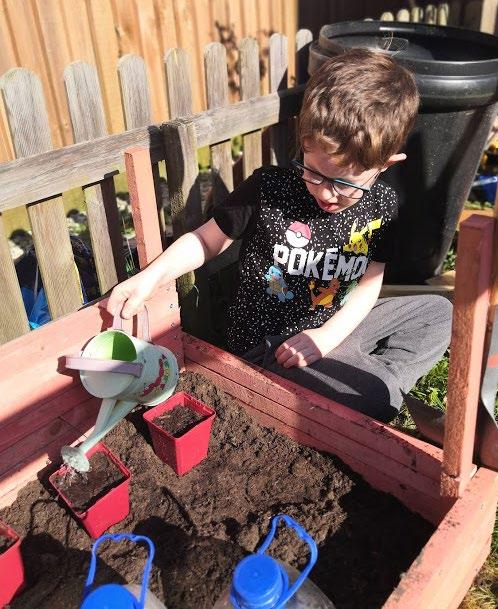
4 minute read
The therapeutic superpowers of play
We asked Child and Adolescent Psychotherapist and Play Therapist, Maggie Fearn to tell us about how playing can help children to make sense of their experiences and the world around them, particularly in times of uncertainty and stress. This is what Maggie had to say about the power of play.
Superpower 1: Play is the child’s preferred medium of communication Play therapists understand the superpowers of play. Play therapists call on these powers to connect with children in distress, to make them feel safe and to co-regulate them by providing sensory play materials that soothe and stimulate. Also, to give the child the space and the time to make sense of their experiences using the symbols and metaphors of imaginative and pretend play.
Advertisement
A characteristic of play is the intensity, and absorption in the present moment. Children are preoccupied when they play, playful experiences are deeply impressive and what is more, if something happens to the child that is confusing, overwhelming or misunderstood the child will act it out symbolically in play to try to make sense of it, rearranging the experience in her own terms.
For example:
Ellie 1 (aged four) has a stick, whacking a tree stump: ‘I’m getting the monster!’
‘You’re getting the monster,’ I remark.
‘Green monster I saw when Mam went out. We watch Tom and Jerry before I go to sleep. Get the monster! It’s green!’
The tree stump becomes the monster. She whacks it hard, talking all the time, and I pay close attention, quietly tracking her every movement. She calms down and pokes the end of the stick into leaves and gives them to me one by one.
‘You’re giving me leaves,’ I say.
She sticks the stick into the ground. ‘This is my stick, it stays here. No one else can use it.’
In her imaginative play Ellie actively confronts her terrors, and as brave as any mythical heroine she overcomes them. Children can act out their experiences in play to make sense of the world, using symbol and metaphor – this gives the therapist insight into understanding the underlying forces driving the child’s nonverbal and unconscious communication.
Superpower 2: Healing happens through play Children play whenever they can. Whilst playing, children grow and develop in all aspects: physically, emotionally, psychologically and cognitively. As children move through life, through play, they integrate their experiences in manageable narrative sequence, establishing neurobiological patterning, each developmental stage building incrementally towards maturity. Intrinsic learning happens at each stage, providing the foundation for what comes next.
Trauma impacts on the flow of development, resulting in profound confusion and distress – the traumatised child is overwhelmed and cannot function to her full potential. Research into play deprivation reveals that children significantly deprived of opportunities to play are more likely to be aggressive, repress emotions, lack social skills and have an increased tendency towards obesity. 2 Chronic, long term deprivation results in depression, withdrawal and decreased neuro-endocrine activity in the brain and nervous system. 3 If children don’t play they suffer.
Not all children need play therapy, but all children need to play. It is an unconscious, self-regulating process oriented towards independence, integration and health. Children who do need therapeutic help can find healing through play. As Ellie demonstrates, a child can manifest her fears as a green monster, which is also a tree stump, and act out her real and urgent need to rise up and
overcome it: a small child discovering her power to manage her feelings by herself. No one planned this for her, or taught her how to do it. In the safety of the therapeutic relationship, she draws on her innate ability to heal herself through play.
Superpower 3: Play is a reflection of the child’s inner world
Play therapists know that a child’s inner world is communicated through their imaginative play. When Ellie sees the tree stump as a green monster, she operates simultaneously on two levels. She is involved in her fantasy, focusing on the make-believe meaning of objects and her actions, at the same time she is still aware of her own identity and the real life meaning of things. In play, children can flow back and forth between fantasy and reality in a way that most adults have lost. 4 In play every child naturally acts out his or her experiences. All imaginative play forms a link from the child’s inner world to the outer world and visa versa: fantasy is the bridge that connects us symbolically with our shared reality.
The outer world is not independent, freestanding and solid. Every one of us creates our own conception of reality in the relationship between our sense of self and our environment, our culture, and the significant people in our lives. Our sense of self as adults continues to evolve in response to life’s challenges and is influenced by the resources we had available when we were children, including our ability and opportunity to access the super powers of play.
Maggie is also a Senior Lecturer MSc Play Therapy at University of South Wales and visiting lecturer at the Children’s Therapy Centre, Ireland. She also works for The Windfall Centre as a play and filial therapist and clinical supervisor.
This is not the child’s real name, and other significant details have been changed to disguise their identity. Manwaring, B. and Taylor, C. (2006) The Benefits of Play and Playwork. Research paper for CYWU. London: SkillsActive. Gaskill, R. and Perry, B.D. (2014) The Neurobiological Power of Play. Using the Neurosequential Model of Therapeutics to Guide Play in the Healing Process. From Creative Arts and Play therapy for Attachment Problems. by Cathy A. Malchiodi and David A. Crenshaw. New York: Guilford Press. Cattanach, A. (1997) Children’s Stories in Play Therapy. London: Jessica Kingsley Publications.









